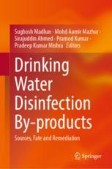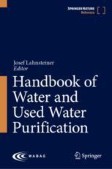Search
Search Results
-
Catalytic hydrogenation of disinfection by-product bromate by cobalt and nickle prussian blue analogues with borohydride
As disinfection is employed extensively, disinfection by-product bromate has become an emerging environmental issue due to its carcinogenic toxicity....
-
Identification of disinfection by-product precursors by natural organic matter fractionation: a review
During disinfection of drinking water, natural organic matter reacts with chlorine to produce harmful disinfection by-products. The identification of...

-

-
Various Disinfection Processes and Formation of Disinfection by-Products in Drinking Water
The increase in the urban population means that water consumption is increasing. In this way, several methods to produce drinking water have been...
-
Improved fractionation method using amphipathic NDAM for the efficient separation of disinfection by-product precursors in natural organic matter
The hydrophilic substances in natural organic matter (NOM) are the main precursor of disinfection by-products (DBPs) formed during disinfection...

-
UV Radiation in Wastewater Disinfection
Discharging treated municipal wastewater into rivers can pose a potential threat to the aquatic environment and human health. This danger results...
-
Alternate disinfection approaches or raise disinfectant dosages for sewage treatment plants to address the COVID-19 pandemic? From disinfection efficiency, DBP formation, and toxicity perspectives
During the COVID-19 pandemic, most sewage treatment plants increased disinfectant dosages to inactivate pathogenic viruses and microorganisms more...

-
Water Disinfection: Background, Current Trends, Challenges, and Gaps
World’s population is growing rapidly and it will touch 10 million by the end of 2050. Availability of clean and safe water for all is a global...
-
Disinfection in Water and Used Water Purification
Disinfection in water treatment has a long tradition. In the course of time, five processes/agents have established themselves in water technology....
-
Designing Smart Disinfection Hangers in the Covid-19 Epidemic
With the rapid development of science and technology, smart furniture has become a technological trend. After the COVID-19 epidemic swept the world,...
-
An effective and rapidly degradable disinfectant from disinfection byproducts
Chloroxylenol is a worldwide commonly used disinfectant. The massive consumption and relatively high chemical stability of chloroxylenol have caused...

-
Evaluation of the effect of chemical disinfection and ultraviolet disinfection on the dimensional stability of polyether impression material: an in-vitro study
BackgroundVarious methods, chemical and physical, disinfect dental impressions. Common chemicals include 1% Sodium Hypochlorite and 2%...

-
Study of bioaerosol disinfection kinetics and application of nonlinear regression modeling for optimization of TiO2-based photocatalytic disinfection process
Bacteria and viruses are some of the major sources of indoor air pollution. Many strategies are utilized to control indoor biopollutants. Among the...

-
A Comparative Study of Different Disinfection Processes, and Management Practices to Control the Formation of Disinfection by-Products (DBPs)
The disinfectant chemical that is most frequently utilized is chlorine. The most popular kinds are calcium or sodium hypochlorite and chlorine gas....
-
Antimicrobial silver nanoparticles for water disinfection: a short review on recent advances
With increasing the biological contamination in drinking water day by day, the demand for fresh drinking water is also increasing. The limitations of...

-
New diamond coatings for a safer electrolytic disinfection
In this work, a new coating of boron-doped diamond ultra-nanocrystalline (U-NBDD), tailored to prevent massive formation of perchlorates during...

-
Sequential injection spectrophotometric method for screening bromate produced as an ozonation water disinfection by-product
The aim of this work was the development of an automatic sequential injection analysis method to monitor the ozonation process for water...

-
High-molecular-weight by-products of chlorine disinfection
Although drinking water chlorination has reduced the incidence of waterborne disease, the reactions of chlorine with organic matter can lead to the...

-
Physicochemical methods for disinfection of contaminated surfaces – a way to control infectious diseases
This paper represents the reviews of recent advancements in different physicochemical methods for disinfecting contaminated surfaces, which are...
-
Voltammetric and spectrophotometric studies of toxic disinfection by-product 2,6-dichloro-1,4-benzoquinone and its behavior with DNA
Water disinfection processes may generate several dangerous substances that can affect both human beings and the environment. As a known contaminant...

